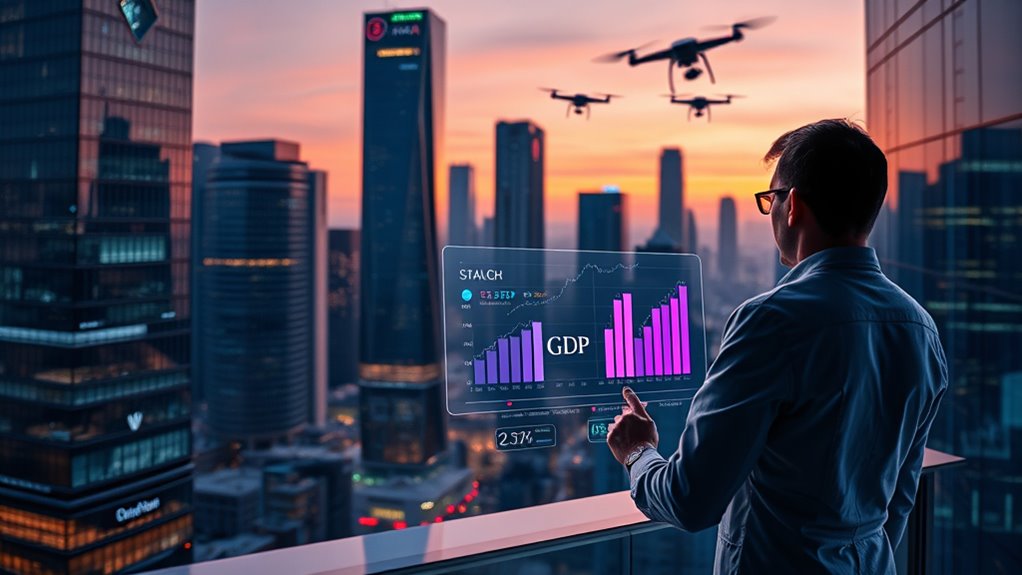As automation and digitalization transform economies, traditional GDP no longer captures their full impact. It struggles with intangible assets, digital services, and productivity gains that benefit high-skilled workers more than overall growth. This often results in an incomplete view of progress and rising inequality. To truly understand where the economy is headed, we need broader measures that include well-being and social benefits. Stick around to discover how new metrics can offer a clearer picture of our evolving economy.
Key Takeaways
- Traditional GDP struggles to accurately measure digital goods, intangible assets, and welfare benefits created by automation.
- Automation benefits often lead to productivity gains that are underrepresented in GDP figures, causing misperceptions of economic progress.
- GDP fails to capture increased inequality and social benefits driven by automation, limiting its effectiveness as a societal wellbeing indicator.
- Alternative metrics like HDI and GPI provide a more comprehensive view of progress in an automation-driven economy.
- Relying solely on GDP is increasingly inadequate; integrating diverse indicators is essential for understanding economic health today.
Rethinking GDP Measurement in a Digital Economy

As digital technologies transform how we create and exchange value, traditional GDP measures struggle to keep pace. You’ll find that GDP misses key aspects of the digital economy, like consumer surplus from free services such as Wikipedia or Google Maps. Quantifying digital goods and services proves challenging because they’re often intangible and borderless, complicating cross-border trade estimates. Additionally, statistical agencies face limited budgets, making it harder to gather the data needed for accurate measurement. This gap drives the need for new metrics, like GDP-B, which aims to include consumer surplus and better reflect digital activities. Understanding digital valuation Without adapting our measurement tools, we risk undervaluing the true scope of the digital economy, leaving policymakers and economists with an incomplete picture of economic health. Moreover, the difficulty in capturing the value of intangible assets hampers our ability to fully assess economic growth in the digital era. Recognizing and incorporating resources and tools available for measuring digital value is essential for developing more comprehensive economic indicators. Developing standardized methods for valuing digital assets will be crucial in closing this measurement gap.
Automation’s Impact on Traditional Economic Indicators

Automation reshapes traditional economic indicators by altering the way you measure employment, productivity, and inequality. While automation creates as many jobs as it destroys over time, these new roles often demand different skills, pushing workers to switch occupations or upgrade their expertise. Industries like manufacturing and retail may experience significant job losses, yet automation also spurs the emergence of new job types, leading to economic disruption. Productivity soars as automation drives efficiency and reduces variable costs, boosting overall economic growth. However, these gains often benefit high-skilled workers, worsening income inequality and widening socioeconomic gaps. Measuring automation’s true impact becomes challenging because traditional statistics struggle to capture digital economy dynamics and sector-specific shifts. Furthermore, the conventional indicators may understate or misrepresent automation’s profound influence on the economy. Understanding these measurement challenges requires recognizing the changing nature of work, which complicates how we interpret economic data and assess progress. Additionally, the difficulty in quantifying productivity gains highlights the limitations of existing metrics in reflecting technological advancements. Recognizing the impact on income distribution is essential for a comprehensive understanding of automation’s socioeconomic effects. Emerging labor market trends further complicate the assessment of automation’s economic influence. Moreover, the limitations of traditional metrics become more apparent as the economy increasingly relies on digital and automated processes.
The Discrepancy Between Productivity Gains and GDP Growth

You might notice that gains in productivity from automation aren’t always reflected in GDP growth. This gap often happens because digital output and quality improvements go unmeasured, and automation can widen economic inequality. As a result, the true economic benefits of productivity boosts can remain hidden or unevenly distributed. Recognizing the limitations of traditional metrics like GDP is crucial in understanding the full scope of economic progress, especially in an era dominated by quantitative easing and technological innovation. Additionally, the rise of digital metrics highlights the need for alternative ways to measure economic well-being beyond conventional indicators.
Unmeasured Digital Output
Have you ever wondered why productivity appears to be improving, yet GDP growth remains sluggish? The answer may lie in unmeasured digital output. Traditional GDP measures often fail to fully account for digital goods and services, which are increasingly central to modern economies. This leads to a gap between actual economic activity and what’s reflected in official statistics. The digital economy’s rapid growth isn’t fully captured, partly due to measurement challenges like valuing intangible digital services and tracking cross-border digital transactions. As a result, productivity gains driven by digital innovation seem larger than what GDP reports suggest. Ongoing efforts aim to improve measurement methods and address these issues, but challenges remain. This mismeasurement could distort our understanding of economic progress, raising questions about whether GDP still accurately reflects the true state of our digital, interconnected economy.
Quality vs. Quantity
While productivity gains from automation and AI are often impressive, they don’t always lead to proportional increases in GDP. Automation can boost productivity by 1.5 percentage points annually, yet GDP growth may lag due to factors like price deflation or sectoral shifts. You might see advanced economies increase GDP per capita markedly through productivity investments, but these gains don’t necessarily translate into higher overall GDP. This disconnect occurs because GDP measures market value, not the full value created by digital and intangible assets, nor the welfare improvements from automation. For example, AI can raise GDP by 2%, but also reduce welfare by 0.72%. The true benefits—like lower prices or better quality of life—often escape GDP’s scope, creating a gap between productivity improvements and economic growth. Furthermore, traditional GDP metrics often fail to capture the social and environmental benefits generated by technological advancements. Recognizing the limitations of GDP is crucial for understanding the real impact of technological progress on society. Moreover, the measurement methods used in GDP calculations often overlook the full scope of value created in modern economies.
Economic Inequality Rise
Automation and AI-driven productivity improvements often don’t lead to proportional GDP growth, revealing a growing economic disparity. High-income workers benefit the most, as their tasks complement AI, boosting wages and productivity. Capital owners see significant gains, widening wealth inequality as firms with AI enjoy higher returns on capital. This concentration of wealth accelerates as those controlling AI technologies accumulate more economic gains. This trend underscores how AI security measures and the development of robust safety protocols are crucial to prevent exploitation and unintended consequences, which can further exacerbate inequality. Although AI can displace some high-income jobs, many workers in these roles see overall gains through task augmentation. Globally, developed countries with advanced AI pull further ahead, increasing international inequality. Developing nations face job losses and reduced competitiveness. Within countries, wage polarization intensifies—middle-class roles shrink, while highly skilled workers prosper. Additionally, the unequal distribution of AI benefits may influence economic metrics, such as GDP, and societal stability over time. This disparity is compounded by the fact that the home furnishings industry, like many others, is affected by technological changes that reshape the job landscape. Moreover, understanding the nuances of ethical hacking can help organizations build resilient cybersecurity defenses against malicious attacks that could threaten economic stability. Ultimately, productivity gains benefit a few, while broad economic growth remains elusive. This trend highlights the increasing importance of understanding how economic metrics may fail to fully capture the distributional impacts of technological change.
New Challenges in Capturing Automated and Digital Services

Capturing the value of automated and digital services in GDP calculations presents significant challenges because these innovations often produce non-monetary benefits or are difficult to quantify. Automation boosts productivity, but this doesn’t always translate into GDP growth, especially when new goods and services emerge that aren’t fully captured in current metrics. The creation of innovative outputs, with complex utility functions and slow growth, further complicates measurement. Digital services often complement existing goods, yet their economic impact remains hard to assess. Additionally, the shift to remote work shows that economies can adapt without large GDP changes, but the ease of task substitution influences how automation affects economic output. Overall, these factors make it tough for traditional GDP measures to accurately reflect the true value generated by automation and digital transformation.
Broader Metrics for Assessing Societal Well-Being

Traditional economic metrics like GDP often fall short in capturing the full scope of societal well-being. You need to look beyond GDP to better understand true progress. Here are four broader metrics that help:
- Human Development Index (HDI): Focuses on education, health, and capabilities, offering a more human-centered view. Incorporating comprehensive indicators can provide a deeper understanding of societal progress beyond economic output.
- Better Life Index: Measures well-being through subjective and social factors like social connections and life satisfaction.
- Genuine Progress Indicator (GPI): Adjusts GDP by subtracting environmental damage and social costs to reflect sustainability.
- Global Frameworks: Incorporate human rights and sustainable development goals, broadening the scope of economic success. Additionally, considering the impact of Worth – Kiss Me on global entertainment and cultural influence can provide insights into societal vitality beyond traditional metrics.
These metrics provide a fuller picture, emphasizing health, environment, and social factors often overlooked by GDP.
Preparing for Future Economic Measurement in an Automated World

As AI-driven automation continues to accelerate, relying solely on GDP to measure economic progress becomes increasingly inadequate. You need new tools that capture automation’s true impact, like productivity gains and inequality. Traditional metrics struggle with complex patterns from emerging goods and services, or regulatory challenges that influence growth. To prepare, consider incorporating alternative indicators and data-driven insights. Here’s a quick overview:
| Metric Type | Focus Area | Limitations |
|---|---|---|
| Productivity Measures | Tracking automation gains | May overlook non-monetary benefits |
| Inequality Indicators | Evaluating income disparities | Difficult to quantify fully |
| Innovation Metrics | Measuring new goods/services | Complex patterns, delayed effects |
| Policy Data | Regulatory impacts | Hard to predict long-term effects |
In this automated era, diversified metrics will help you better understand economic health and guide smarter policies.
Frequently Asked Questions
How Can We Accurately Measure the Value of Automated Digital Services?
You can better measure the value of automated digital services by combining metrics like consumer surplus, user engagement, and intangible benefits such as collaboration and customer perception. Use innovative methods like online choice experiments to gauge consumer willingness to pay and develop holistic frameworks that include soft metrics. Tracking both tangible outcomes like revenue and softer impacts helps you capture the full value these services provide beyond traditional financial measures.
Will Automation Increase Economic Inequality Despite GDP Growth?
You might worry that automation will widen economic inequality even if GDP grows. While automation boosts productivity and can increase overall wealth, it often benefits high-skilled workers and capital owners more than lower-wage earners. This creates a gap, making inequality worse. So, yes, automation can raise inequality despite GDP growth, unless policies like retraining and redistribution are put in place to address these disparities.
What New Metrics Could Better Reflect Societal Well-Being Beyond GDP?
Did you know that over 70% of people worldwide rate their well-being as important? This shows that societal health isn’t just about economic numbers. Instead, you should look at metrics like the Human Development Index or the Better Life Index, which focus on health, education, and social connections. These measures give a fuller picture of progress, helping you understand true societal well-being beyond just GDP.
How Quickly Can Existing Economic Indicators Adapt to Automation-Driven Changes?
You wonder how fast existing economic indicators can adapt to automation-driven changes. The truth is, they often lag because they focus on traditional metrics like labor and production, which automation transforms rapidly. To keep up, you need to develop new, flexible indicators that incorporate data from AI and automation tools. This way, you’ll better capture productivity shifts and economic impacts, ensuring your metrics stay relevant in a fast-changing technological landscape.
What Policies Are Needed to Balance Automation Benefits With Economic Stability?
Imagine steering a ship through stormy waters; you need steady hands and clear strategies. To balance automation benefits with stability, you must implement smart policies like investing in workforce reskilling, taxing automation to slow its pace, and supporting sectors vital for growth. These actions act as your compass, guiding the economy safely forward while harnessing innovation’s potential without risking chaos or displacement.
Conclusion
As automation reshapes our economy, it’s clear that traditional GDP may no longer fully capture progress. You might wonder if focusing solely on output overlooks well-being and innovation. Maybe a new metric, blending digital, societal, and environmental factors, offers a truer picture. Embracing these changes isn’t just smart — it’s essential for understanding your economy’s real health in this automated age. Could redefining success lead to a fairer, more accurate future?









